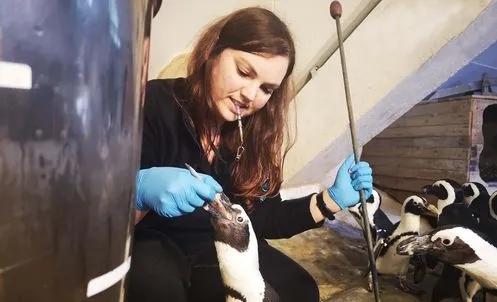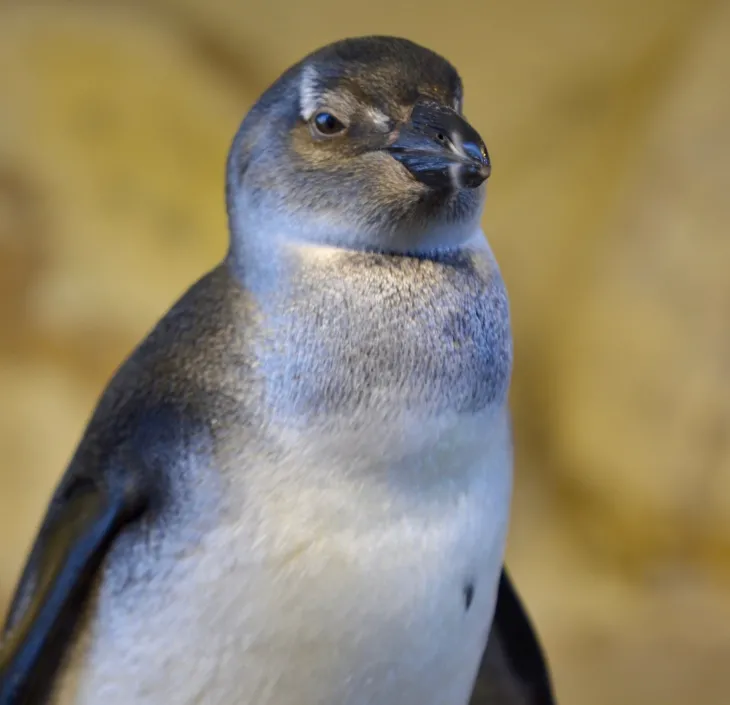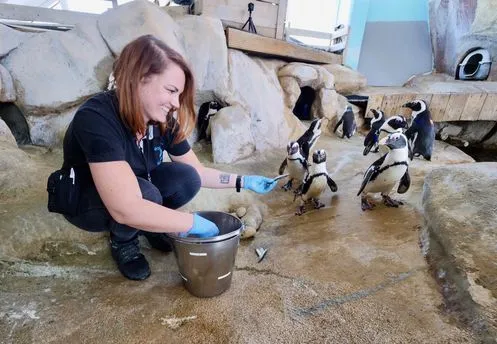Constance works as a handler in the Aquariology team at Nausicaá.. She is responsible for the colony of African penguins. Between preparing meals, feeding, caring for the penguins every day, observing the eggs and monitoring the births, Constance took time out to answer our questions.
Interview with Constance, penguin handler at Nausicaá
Day-to-day care for the African penguins

3 questions for Constance, Nausicaá's penguin manager
Can you tell us more about the birth of baby penguins and how they grow?
At birth, a baby penguin measures between 10 and 12 cm and weighs around 70 g. The parents keep a close eye on their young and feed them until they are two or three months old. Once they have reached the age of two months, they are already as big as their parents and start to leave the nest to explore their territory.

Young penguins keep their grey juvenile plumage for a year.
Why is Nausicaá committed to preserving African penguins?
The African Penguin lives in South Africa and is a particularly vulnerable species in the face of the threats posed by human activities. Owing to climate change, the fish on which the penguins feed are on the move as a result of warmer water, and they are also being negatively affected by overfishing. The parent penguins must therefore swim further and further away to catch the fish they need to feed their young and many of the chicks die awaiting their parents’ return. Oil pollution, tourism and the resulting coastal constructions, not to mention accidental captures linked to fishing are putting even more pressure on penguin populations.
Predators such as seals, sharks and land animals are also a threat to this vulnerable species that depends on humans for its conservation.
“The population, which numbered one million breeding pairs in the 1930s, has declined by more than 97%: less than 2% of the current penguin population now lives in the wild.”
Thanks to the work we’ve been doing since 2006, we’ve managed to raise a colony of 22 adult penguins, all of whom were born in European parks and aquariums. The couples that have formed in the colony have been able to find the space they need for their intimacy at Nausicaá: since their arrival, they have given birth to around twenty babies. Nausicaá is taking part in a European conservation programme for African penguins. Young penguins are sent to partner establishments to preserve a healthy gene pool.
“These births are essential for the preservation of the species: these new individuals in turn enable other centres to expand their breeding programmes.”

What are you doing for the penguins living in the wild in South Africa?
Nausicaá supports SANCCOB (Southern African Foundation for the Conservation of Coastal Birds), which campaigns for the preservation and rehabilitation of oil-coated, injured, sick and orphaned marine birds. Present in South Africa, SANCCOB essentially takes care of African Penguins. This association also carries out research, training and awareness-raising actions to enable the African Penguins to build up their colonies: every year they care for a thousand penguins and release them to their natural habitat!
Nausicaá and its Endowment Fund are also committed to raising funds to support SANCCOB’s initiatives, and promote them to inform and raise the awareness of as many people as possible regarding the protection of African Penguins.
“The donations collected at Nausicaá have already enabled SANCCOB to save 200 penguins, some of which have been released by the Nausicaá teams on the spot.”
These donations also make it possible to raise awareness regarding conservation through environmental education and to take part in research projects.
Nausicaá supports the SANCCOB association
Nausicaá sponsors the SANCCOB (Southern African Foundation for the Conservation of Coastal Birds) association of volunteers working in South Africa to rescue African penguins and other seabirds. This association takes care of injured animals and in particular, those injured from oil spills. It also rescues and rears the chicks to release them back into the wild after a few months.